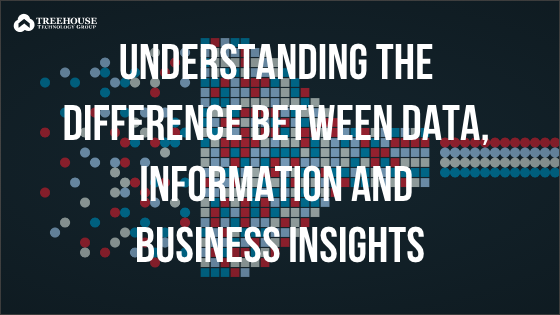Data, information, and insights are not synonymous. How exactly do they differ? We can appreciate the difference better if we use an example from art. The brush strokes and colors used by Leonardo da Vinci to paint the Mona Lisa are data. The image of a woman that’s visible to us is information. The understanding that this woman bears a resemblance to many Renaissance representations of the Virgin Mary is an insight.

What do the terms data, information, and insights mean in the context of business?
Data consists of raw and unprocessed facts and may include numbers, images, audio or video files, readings from machines, etc. Data is the basic unit of measurable facts and can be stored and transmitted. Every business generates data, practically at every moment, but in its raw form, it isn’t particularly useful.
That’s why we process and analyze data so that we can harvest information from it. Information is a collection of data points that helps us to understand what is being observed and measured. Essentially, information is data that has been processed, aggregated, and organized in order to reveal meaning.
When information is seen in a context and knowledge and experience are brought in to interpret it, you get business insights. Information helps us to observe what is happening, while insights explain why. These business insights help to arrive at decisions and define strategy.
Insights dive deeper into data and connect dots that may seem unrelated to shed light on the questions under consideration.
As an example, let’s say that you are told that the marketing team received 2,000 leads last month. On its own, this data point doesn’t tell you anything. Is it something you celebrate or do you need to overhaul your lead generation process completely?
Now, let’s say that you are shown the same data point along with the data for the past 6 months and as a bar graph. You are also shown the targets for new leads. The data now has a context, and you gather the information that leads had been growing at about 9 to 10% each month, but just in the last month, they grew by 20%. You have also learned that this was the first month that the lead target was achieved. By looking at the historical data and the graphical representation, you know that something has gone right in the last one month. Now you need to identify what that is so that you can do more of it.
When you dig deeper, you find that most of the growth in leads has come from the live chat window of your website, which has been recently deployed. This gives you the insight that website visitors prefer to share their requirements on live chat as compared to filling out a form or sending an email.
Now you start analyzing the messages that are coming on the live chat. You start observing whether the live chat agents have fulfilled queries well and maximized opportunities. You decide to invest in further training and enhancing the live chat capability. You also consider whether you should have the live chat available on the website for longer hours.
As you will see, in this and other examples, powerful insights are rarely obtained by looking at just one dimension of data. Context and correlation are important in order to reveal insights. Data analytics platforms and technologies that have the capability of synthesizing data of different types are important in order to get the best insights.
The concepts of data, information, and business insights are often illustrated as a pyramid with data at the bottom, information in the middle, and insights at the pinnacle. The processes and technology tools essential in the data layer are to do with data storage, cleansing, deduplication, data management, and ingestion into the analytics platform. In the information layer, the tools are related to dashboards, visualization, and data modeling. The tools and technologies for the insights layer must be capable of predictive analytics, scenario analysis, and blended queries. Artificial intelligence and machine learning can now be applied effectively in order to generate insights from data. This is called augmented analytics.
Customer data, information and business insights
Data about customers and the insights that it reveals is of strategic interest to all businesses. There are a very large number of possible sources of customer data. The footfall in retail stores, purchase behavior, loyalty program data, response to promotional offers, website visitors, website or mobile app usage analytics, and online purchases are some of the data points that you can capture within your organization. You may also choose to conduct market surveys to gather more data, conduct social media listening, or you could subscribe to third party market research.
Most of this data may be numerical and stored in a tabular format, while some, such as social media posts, may be a mix of text images and videos. So you now have a huge volume of data of many different types.
If this data could help to further your understanding of customers — their behavior, attitudes, likes, dislikes, pain points, demography, motivation, and what competing choices are they considering — it would help you to make more informed business decisions.
For instsance, you would know the right product strategy, new designs required, pricing, which distribution channels are working best for you, which promotional campaigns or ads are effective, whether any friction in online purchases is causing customers to drop off, which segment of customers is using what, etc. You would even have granular level intelligence, such as which color option is doing the best in a particular product category.
In order to answer these questions, you need to make sense of the data. Data visualizations, reports, and dashboards are used to view and present the data, so that information can be gleaned from it. Now you can work with information, which is a collection of data points that help you to understand your customers better. There are a number of techniques available to help you interpret this information. For example, you could calculate averages, percentages, or ratios. Graphical techniques, such as line charts, bar graphs, or pie charts, help to see the nature of data, trends over time, etc.
But modern data analytics technologies can yield business insights that go far beyond what tables and charts can reveal. You can now see different types of information in conjunction, to understand whether one factor is influencing another — or if there are any correlations or causes. You can also view the information and then apply the knowledge of an expert to get a better context and a deeper meaning from the information.
So, let’s say that you have three product lines: economy, standard, and premium. The sales of your premium line have been showing healthy growth and you have also been investing in marketing for it. But, in recent months, sales of the premium line begin to decline in some states around the country. At first, you suspect that the ads and promotions have not been appreciated in those states. So you conduct surveys to see consumer perception about the ads. The findings of the survey do not show any marked difference between the perception among consumers of those states and other states where the premium line is still doing well. You speak with your sales managers of those states and ask them what they think the problem could be. Most of them mention that a few large corporations have been struggling and have laid off people, and this has affected their states to a fairly large extent.
In order to understand this better, you now look at the macroeconomic data of each state and the employment figures. Unemployment has recently risen in the states where your premium line is not performing well anymore. This gives you the business insight that when people are uncertain about their jobs, one of the first purchases that they will postpone or cancel is your premium line. With this insight, you can plan your next moves. You examine the employment data about other states carefully and decide strategically whether to invest in advertising the premium line in each state. You also get a sense of other states where unemployment figures are likely to rise, and start thinking about how you will mitigate the fall in sales. You also think about how your product line can better serve consumers who are concerned about the future of their jobs. Do you need to plan the product portfolio, pricing, messaging, distribution, or advertising differently for them?
These are some examples that show that effective data analytics technologies reveal insights that can be applied to make the right decisions in business, which is why they are often called “actionable insights.” Powerful analytics technologies and machine learning capabilities make it possible for everyone to experience the benefits of business insights.




1 thought on “Understanding the Difference Between Data, Information and Business Insights”
Comments are closed.